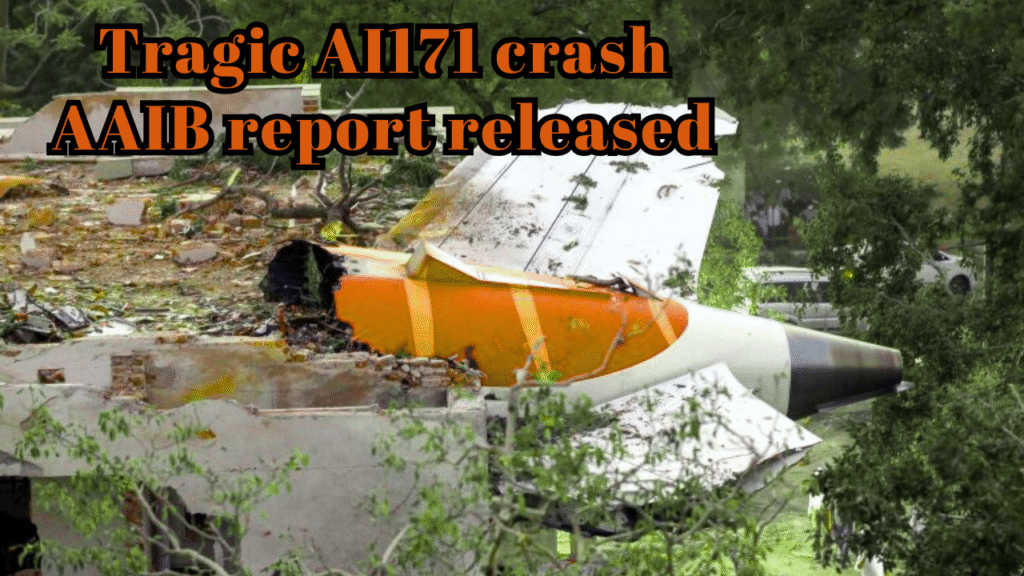260 people died in the AI171 crash on June 12. Investigations reveal a severe fuel switch problem. Read the report from the Aircraft Accident Investigation Bureau about how both engines failed despite a brief recovery.

Tragic AI171 crash on June 12: investigation shows fuel switch failure and engine failures
The Aircraft Accident Investigation Bureau (AAIB) has found important new information about the terrible crash of the Ahmedabad-London AI171 Dreamliner on June 12, which killed 260 people. The AAIB’s study, released a month after the tragic incident, provides alarming details about the events that led to the failure of both engines.
Fuel control switches caused problems within seconds after takeoff.
The Civil Aviation Ministry’s first inquiry found that just seconds after takeoff, both fuel control switches were switched from “RUN” (fuel flowing) to “CUTOFF” (fuel halted), which set off a chain of events that led to the crash. The pilots experienced confusion in the cockpit and an uncomfortable conversation due to the one-second interval between switch movements.
The cockpit tape captures one pilot asking, “Why did you cut off the fuel?” The other pilot said, “I did not do so.” The fuel control switches moved in a way that wasn’t planned, which is a big problem because they shouldn’t be able to be switched by accident. Serious concerns arise about their involvement in the crash.
Engine Failures: Quick recovery and then loss of thrust
The examination also showed that both engines lost thrust at first, but Engine 1 briefly regained it. The engine’s core deceleration halted, went back, and started to become better. Sadly, this recovery didn’t last long. The second engine, on the other hand, couldn’t stabilize since its core deceleration kept going, even though they tried to restart it and increase the flow of fuel.
The fuel cutoff switch for Engine 1 was switched from “CUTOFF” to “RUN” at 08:08:52 UTC. This momentarily stopped the core from slowing down. Engine 2’s fuel control switch, on the other hand, changed from “CUTOFF” to “RUN” two seconds later. Even though Engine 1 seemed to be getting better at first, both engines failed to settle, which caused the accident.
The APU: A Possible Cause of the Engine Failures
The report says that two seconds after the fuel switch was switched for Engine 1, the Auxiliary Power Unit (APU) inlet door started to open during takeoff, which made the situation much more complicated. Experts say that the APU, which provides electrical and pneumatic power while the plane is on the ground, could have disrupted the airflow. The failure of the APU system may have exacerbated the thrust loss, further worsening the situation.
A Closer Look at the Investigation: What Went Wrong
The AAIB’s report talks about how the fuel control switches participated in this catastrophe. The analysis points to a number of mistakes and problems that caused the engines to not be able to recover after losing thrust. Engine 1’s brief recovery gave us a moment of hope, but it didn’t stabilize the plane, and Engine 2’s failure was critical.
Experts have asked for more research into the APU’s role and the right way to deal with problems like this in the cockpit. The results are likely to lead to new safety rules in the aviation sector since they could cause more problems with airflow and because recovering an engine is so complicated.
What happened after AI171 crashed: What we learned
As the inquiry into the AI171 disaster on June 12th goes on, aviation experts are asking for a full assessment of safety procedures and the reliability of equipment. Engine 2’s inability to steady and the failure of the fuel control switches highlight the need for pilots to receive better training and more thorough checks during critical situations.
This tragedy has brought up the important topic of how reliable aircraft engines are, showing how important it is to have strict safety systems that can stop catastrophic failures, especially right after takeoff.
Conclusion: The future of aviation safety
The AI171 disaster serves as a sobering reminder of the intricacies of contemporary aviation and the vital role that each and every system component plays. It is believed that as investigators piece together the facts, their conclusions will result in better aircraft systems, enhanced pilot training, and stricter safety procedures to guarantee that a catastrophe like this never happens again. ENDS.

Pingback: Kapil Sharma's Cafe Under Attack: The Shocking Reason Behind Terrorists' Gunfire Explained!
Pingback: Priya Nair: HUL’s First Female CEO and MD – Her Inspiring Journey and Academic Excellence -
Pingback: Sabih Khan: Apple's New COO from Moradabad, UP – All You Need to Know About His Journey
Pingback: Earthquake of Magnitude 4.4 Rocks Haryana, Tremors Felt Across Delhi-NCR – Full Report
Pingback: "Top Profitable Professional Courses After 12th: Boost Your Career with These High-Earning Opportunities"